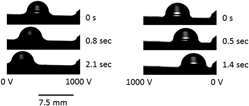Crossref Citations
This article has been cited by the following publications. This list is generated based on data provided by
Crossref.
Passoni, Luca
Bonvini, Giacomo
Luzio, Alessandro
Facibeni, Anna
Bottani, Carlo E.
and
Di Fonzo, Fabio
2014.
Multiscale Effect of Hierarchical Self-Assembled Nanostructures on Superhydrophobic Surface.
Langmuir,
Vol. 30,
Issue. 45,
p.
13581.
Takada, Yasuhiro
Sakai, Munetoshi
Isobe, Toshihiro
Matsushita, Sachiko
and
Nakajima, Akira
2015.
Preparation and hydrophobicity of solid–liquid bulk composite using porous glass and fluorinated oil.
Journal of Materials Science,
Vol. 50,
Issue. 23,
p.
7760.
Sakai, Munetoshi
Kato, Tomoya
Ishizuka, Norio
Isobe, Toshihiro
Nakajima, Akira
and
Fujishima, Akira
2016.
Bio-inspired highly hydrophobic surface with ecdysis behavior using an organic monolithic resin and titanium dioxide photocatalyst.
Journal of Sol-Gel Science and Technology,
Vol. 77,
Issue. 1,
p.
257.
Yokoyama, Kota
Sakai, Munetoshi
Isobe, Toshihiro
Matsushita, Sachiko
and
Nakajima, Akira
2017.
Droplet viscosity effects on dynamic hydrophobicity of a solid–liquid bulk composite prepared from porous glass.
Journal of Materials Science,
Vol. 52,
Issue. 1,
p.
595.
Rowthu, Sriharitha
Balic, Edin E
and
Hoffmann, Patrik
2017.
Molecular dimensions and surface diffusion assisted mechanically robust slippery perfluoropolyether impregnated mesoporous alumina interfaces.
Nanotechnology,
Vol. 28,
Issue. 50,
p.
505605.
Takahashi, Hirokazu
Higashino, Yuta
Sakai, Munetoshi
Isobe, Toshihiro
Matsushita, Sachiko
and
Nakajima, Akira
2018.
Sliding of water–glycerol mixture droplets on hydrophobic solid–liquid bulk composites using Ti plates with a fibrous TiO2 layer.
Journal of Materials Science,
Vol. 53,
Issue. 2,
p.
1157.
Peppou-Chapman, Sam
Hong, Jun Ki
Waterhouse, Anna
and
Neto, Chiara
2020.
Life and death of liquid-infused surfaces: a review on the choice, analysis and fate of the infused liquid layer.
Chemical Society Reviews,
Vol. 49,
Issue. 11,
p.
3688.
Atthi, Nithi
Suwan, Mantana
Sangwong, Nuchjarin
Pattamang, Pattaraluck
Sripumkhai, Witsaroot
Meananeatra, Rattanawan
Saengdee, Pawasuth
Thongsook, Oraphan
Ranron, Norabadee
Pankong, Krynnaras
Uahchinkul, Warinrampai
Jeamsaksiri, Wutthinan
and
Supothina, Sitthisuntorn
2021.
Fabrication of slippery liquid-infused porous surfaces for anti-fouling applications.
Japanese Journal of Applied Physics,
Vol. 60,
Issue. SC,
p.
SCCJ04.
Lin, Ching-Bin
Chang, Han-Sen
Zhang, Yulin
Yang, Fuqian
and
Lee, Sanboh
2021.
Spreading of Water Droplets on Cellulose-Based Papers: the Effect of Back-Surface Coating.
Langmuir,
Vol. 37,
Issue. 1,
p.
376.
Baumli, Philipp
D'Acunzi, Maria
Hegner, Katharina I.
Naga, Abhinav
Wong, William S.Y.
Butt, Hans-Jürgen
and
Vollmer, Doris
2021.
The challenge of lubricant-replenishment on lubricant-impregnated surfaces.
Advances in Colloid and Interface Science,
Vol. 287,
Issue. ,
p.
102329.
Pakzad, Hossein
Nouri-Borujerdi, Ali
and
Moosavi, Ali
2022.
Drag reduction ability of slippery liquid-infused surfaces: A review.
Progress in Organic Coatings,
Vol. 170,
Issue. ,
p.
106970.
Nakajima, Akira
and
Sakai, Munetoshi
2023.
Handbook of Self‐Cleaning Surfaces and Materials.
p.
669.
